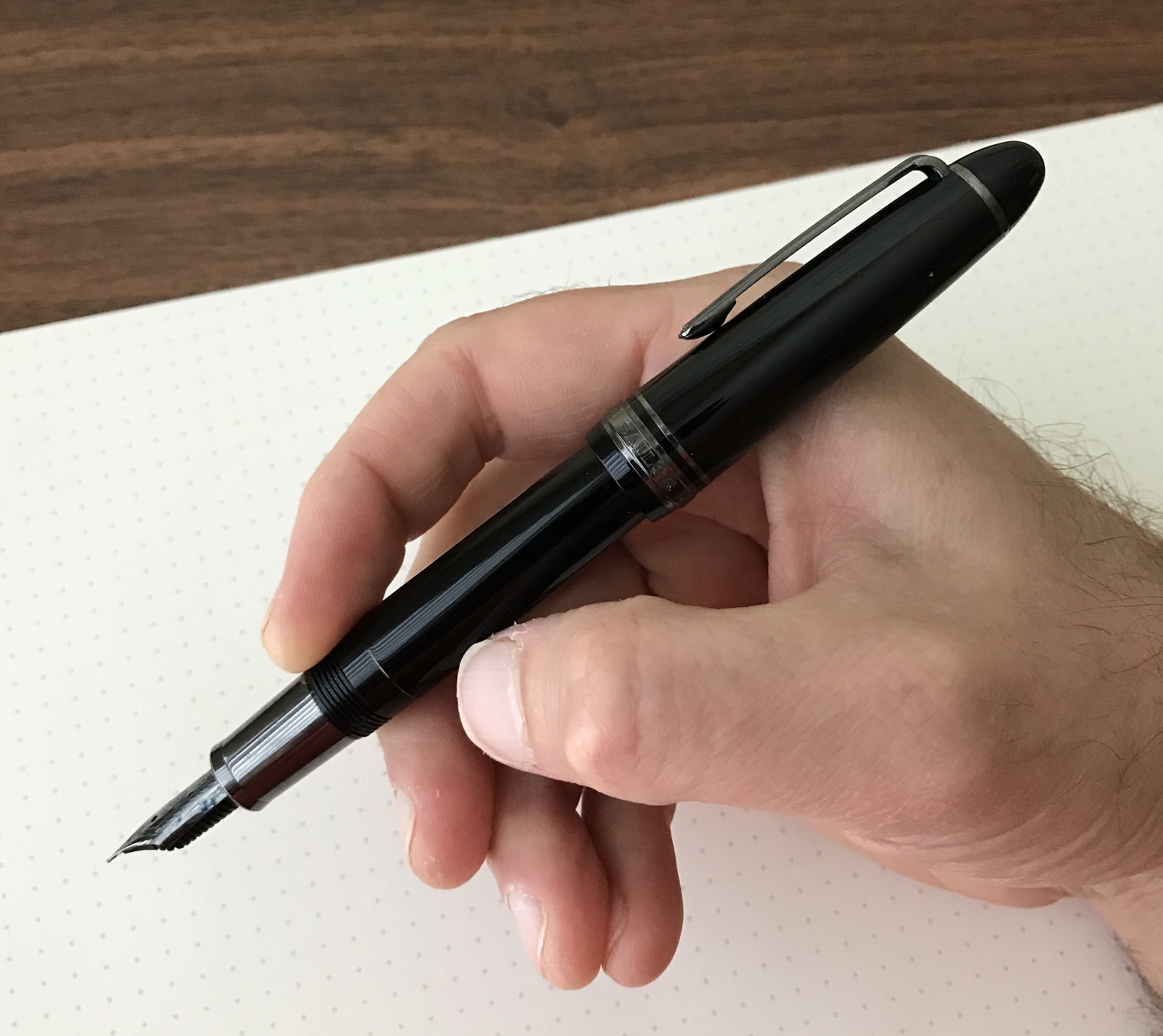This was a very hard review for me to write, and it's been in the works for quite some time. Not because I don't like the pen: to the contrary, the Sailor 1911 Black Luster is one of my favorite writers, alongside the Sailor Pro Gear Imperial Black. But while I enjoy the build quality, the "blacked out" color scheme, and the excellent all-around writing experience that this pen offers, I do believe that it's priced too high, at least in the U.S. market.
Design and Build Quality
The Sailor 1911 Black Luster compared to a Montblanc 146.
I've reviewed the regular Sailor 1911 Large before, and as I observed in my previous review, to the untrained eye this pen would be a dead-ringer for a Montblanc 146 (without the Snowcap and piston-filler, of course). The 1911 Black Luster, however, does have some significant differences, featuring black ion-plated trim on the clip, cap band, and barrel. It also has a metal ion-plated section, which gives the pen a totally different feel in-hand. It's front-weighted, which when paired with the somewhat softer ion-plated nib (discussed further below), makes for a comfortable writing experience without throwing off the balance. Ordinarily I'm not the biggest fan of pens with metal sections, but something about this one is different. Perhaps the ion plating gives it a slightly "grippier" texture? For whatever reason, I haven't had any issues with the section slipping out of my fingers.
Nib and Writing Experience
Like most Sailor nibs, this Hard Fine (or H-F) was an exceptional writer straight out of the box, and wrote a very fine, yet still wet, line. The 21k ion-plated nibs on the Pro Gear Imperial Black and the Black Luster are somewhat "springier" than the standard Sailor nib. They're not flexible, or even close to semi-flex, but they have a bit more cushion and write a slightly wetter line than the hard-as-a-nail H-F or H-M non-plated nibs.
The scrollwork on the Sailor nibs looks especially nice on the black ion-plating.
On a cautionary note: since these blacked out 21k nibs are softer, they are VERY easy to bend and/or spring. I've had to send a couple of them off to be adjusted/straightened due to minor drops that probably wouldn't have affected a 14k (and certainly not a stainless) nib.
Takeaways and Where to Buy
The Sailor 1911 Black Luster is one of those pens that falls victim to Sailor's strange pricing differences between the U.S. and Japan. While Sailor always prices their "blacked out" pens higher than their other models, here the U.S. "street price" of a 1911 Black Luster is $392, compared to $248 for the regular 1911 Large. To make things even more difficult for U.S. retailers, Japanese sellers typically have the Black Luster listed anywhere from $200-260 on eBay, while there's not nearly as large of an "eBay discount" on the regular 1911.
Note: I'm not going to link to any specific eBay sellers here, because I haven't put any serious effort into vetting specific individual sellers and any eBay purchase should be made only if one is well-aware of the risks (i.e. potential fakes, long shipping times, bait-and-switch, etc.).
I love this pen, but at the nearly $400 price point, I would say that you'd have to want this pen pretty badly to pay Sailor's current asking price. While the ion-plated nib and section obviously adds some cost to the pen, the total price strikes me as a bit steep. That said, I much prefer the balance and the nib of the 1911 Black Luster over the Montblanc Meisterstuck Ultra Black, and the pricing on the Black Luster compares favorably to the Montblanc. If you're considering spending $650+ on the blacked-out Montblanc, I'd consider the Black Luster as an alternative.
Disclaimer: I purchased the pen featured in this review with my own funds, for my own collection. This post contains affiliate links. Any discussion of pricing and availability is current as of the time of publication of this review.








